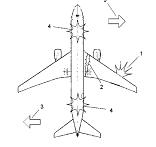
« PREVIOUS ENTRY
The smell-o-vision iPod

An inventor in Bangkok has just patented a new way to safely crash-land a plane: By blowing one of its wings off and sending it into a spiralling dive, which — he claims — would give it a helicopter-like soft landing.
Here’s how it works, in his words:
A signal from the altimeter will detonate the explosive charges, with the thrust forward 1, causing a controlled separation of the wing, and the thrust needed to cause a very strong force in the rearward direction of this wing. The explosive devices will provide enough to break the wing from the airplane at the fuselage 2. This force will then, make the whole airplane spin on a horizontal plane and in the direction of the missing wing 3. This spin will cause the following: [0006] (1) The spin will cause centrifugal force between the wing that remains intact and the fuselage. Thus maintaining the horizontal plane of the airplane while in a spiral spin. [0007] (2) The spin will cause the intact wing to work in the same manner as the rotor of the helicopter, producing lift, so that the airplane slowly decreases altitude, instead of a free fall descent.
“Attention, passengers. In the event of a need for a crash landing, please return to your seats, fasten your seat beats, and stow your tray tables — before we rip the left wing off and turn this airplane into a shrieking, plunging PINWHEEL OF DEATH.”
(Thanks to the New Scientist Invention Blog for this one!)
I'm Clive Thompson, the author of Smarter Than You Think: How Technology is Changing Our Minds for the Better (Penguin Press). You can order the book now at Amazon, Barnes and Noble, Powells, Indiebound, or through your local bookstore! I'm also a contributing writer for the New York Times Magazine and a columnist for Wired magazine. Email is here or ping me via the antiquated form of AOL IM (pomeranian99).

ECHO
Erik Weissengruber
Vespaboy
Terri Senft
Tom Igoe
El Rey Del Art
Morgan Noel
Maura Johnston
Cori Eckert
Heather Gold
Andrew Hearst
Chris Allbritton
Bret Dawson
Michele Tepper
Sharyn November
Gail Jaitin
Barnaby Marshall
Frankly, I'd Rather Not
The Shifted Librarian
Ryan Bigge
Nick Denton
Howard Sherman's Nuggets
Serial Deviant
Ellen McDermott
Jeff Liu
Marc Kelsey
Chris Shieh
Iron Monkey
Diversions
Rob Toole
Donut Rock City
Ross Judson
Idle Words
J-Walk Blog
The Antic Muse
Tribblescape
Little Things
Jeff Heer
Abstract Dynamics
Snark Market
Plastic Bag
Sensory Impact
Incoming Signals
MemeFirst
MemoryCard
Majikthise
Ludonauts
Boing Boing
Slashdot
Atrios
Smart Mobs
Plastic
Ludology.org
The Feature
Gizmodo
game girl
Mindjack
Techdirt Wireless News
Corante Gaming blog
Corante Social Software blog
ECHO
SciTech Daily
Arts and Letters Daily
Textually.org
BlogPulse
Robots.net
Alan Reiter's Wireless Data Weblog
Brad DeLong
Viral Marketing Blog
Gameblogs
Slashdot Games